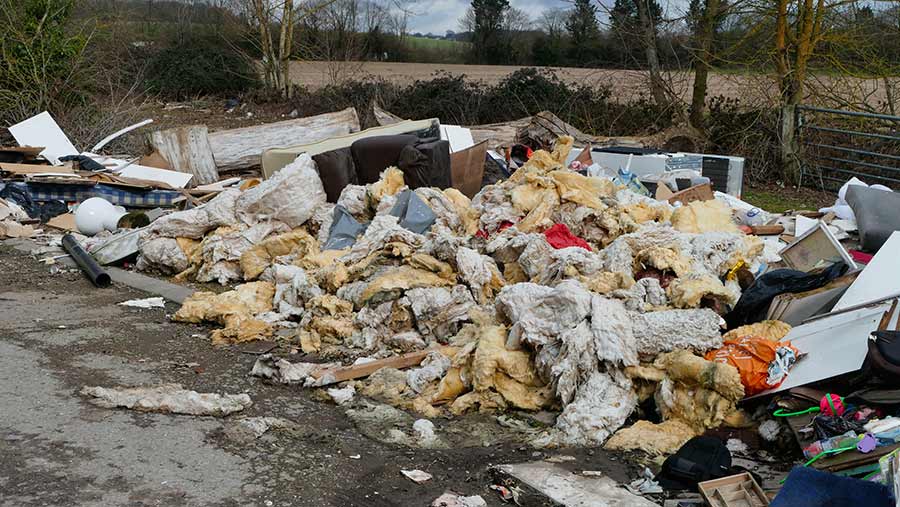Warning over farm ditches to combat criminals
 Trenches are seen as a way to thwart fly-tippers and hare coursers © Geoffrey Swaine/REX/Shutterstock
Trenches are seen as a way to thwart fly-tippers and hare coursers © Geoffrey Swaine/REX/Shutterstock Farmers who dig trenches around fields to keep out criminals could find themselves in breach of stewardship and basic payment rules, it has emerged.
Fed up with being targeted by hare coursers and fly-tippers, an increasing number of farmers are digging ditches, dykes and other earthworks around their land.
See also: Farmers use ‘medieval’ methods to combat rural crime
The practice is seen as a simple but effective way of preventing illegal trespass – potentially saving farmers thousands of pounds from damaged crops and clean-up bills.
But now Defra’s farm advisory service has said it views these ditches as watercourses – even though they were never designed to hold or convey water.
The decision has implications for farmers who claim support under the Basic Payment Scheme, a stewardship scheme or the English Woodland Grant Scheme (EWGS).
In response to an email inquiry, Defra’s farm advisory service said the ditches were classed as watercourses under cross-compliance rules.
‘Good condition’
The rules require land to be kept in Good Agricultural and Environmental Condition (GAEC).
“A watercourse is defined as all surface waters, including coastal water, estuaries, lakes, ponds, rivers, streams, canals and field ditches (including blind ditches),” it said.
“It includes temporarily dry watercourses. This means that for the purposes of GAEC 1 a watercourse is a feature which is capable of holding water at any time.
“Therefore, the ditches dug to prevent hare coursing, although not designed to carry water, do meet the definition of a watercourse and do have to comply with GAEC 1.”
Among other rules, GAEC 1 requires farmers to undertake a number of measures.
These include “all reasonable steps” to maintain green cover on land adjacent to a watercourse or field ditch.
Farmers must also avoid cultivating and applying fertilisers or pesticides to land within two metres of the centre of a watercourse or field ditch.
Failure to abide by the rules could see farmers penalised, losing some or all of their support payment.
‘Needless bureaucracy’
Confirmation that the ditches are classed as watercourses comes as farmers and their representatives are preparing 2019 basic payment claims.
Katie Hilton, an associate with Cambridge-based farm consultant Cheffins, said farmers hit hard by hare coursing were now faced with a needless level of bureaucracy.
Many farmers in the region had dug trenches along field boundaries in a bid to thwart criminals.
“This has often meant digging a single furrow along a roadside where there isn’t already another type of barrier in place such as a hedge or ditch,” she said.
“It puts another level of burden on farmers in situations where the intention is simply to prevent illegal hare coursers from gaining entry.”
Ms Hilton said Cheffins was advising farmers to take a cautious approach by creating a buffer strip alongside these trenches at the earliest opportunity.
Farmers should reacquaint themselves with GAEC 1 rules so they couldn’t be held in breach of cross-compliance obligations in the event of an inspection, she added.
‘Big attraction’
Tim Price, rural affairs specialist with insurers NFU Mutual, said farmers should check they weren’t in breach of cross-compliance rules.
“The big attraction of security ditches and earth banks is that they are effective, low cost, low maintenance and have low visual impact,” he said.
“For farmers who have arable land bordering land without fencing or hedges who are being plagued by hare coursers and thieves they are well worth considering – but checks do need to be carried out before shifting earth.”
These included Basic Payment Scheme rules, Greening and Cross Compliance requirements; Environmental Stewardship and Countryside Stewardship schemes.
“If land includes – or borders – Sites of Special Scientific Interest (SSSI), Special Areas of Conservation (SAC) and any scheduled monuments, the security scheme will need to be cleared with these bodies too.
“After completing banks or ditches, farmers should ensure grass margins are replaced, water courses are flowing and that water runoff is properly contained.”
